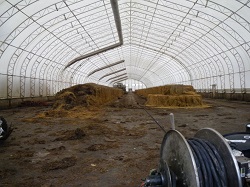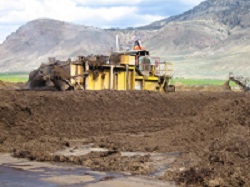Mushroom Compost Facilities
Facilities producing mushroom growing substrate (also called mushroom compost) using a composting process are regulated by the Mushroom Compost Facilities Regulation (MCFR) under the Environmental Management Act (EMA).
The MCFR includes rules for managing discharges to the air (emissions), for managing solid wastes, and for managing liquid wastes (referred to as goody water in the regulation).
The MCFR only regulates discharges from the production of the mushroom compost (Phases 1 and 2). Once the mushroom growing starts (Phase 3), the operation must follow the Code of Practice for Agricultural Environmental Management.
This page is a summary intended to assist in understanding the requirements under the regulation. For detail, the regulation should be referred to. For legal purposes, the Environmental Management Act, and the regulation take precedence. Other provincial and federal legislation or regulations, guidelines and beneficial management practices that are not described in this document may also apply to mushroom compost facility operations.
Municipal Bylaws
Municipalities may also have bylaws that regulate mushroom compost facilities. These bylaws may regulate a variety of different activities, including solid and liquid (effluent) waste management. Municipalities should be contacted for more information.
Requirements Summary
Amendments to the MCFR became effective in November 2013. This regulation applies to mushroom compost facility operators that are producing a mushroom growing substrate using a composting process and have discharged to the environment. The regulation covers requirements for managing emissions, the solid or liquid wastes from the composting process, and for storage.
Solid or liquid waste discharges into the environment are not authorized under this regulation. The liquid waste (e.g., leachate from the composting process and site-surface water from rain, or wash-down water – also termed goody water) must be collected and contained, and not allowed to be discharged into the environment, unless site-specific authorization is obtained. The goody water is so termed for its beneficial re-use to moisten the composting piles.
Emissions
When the materials to be composted (termed feedstock) are mixed and ready to be set in piles for the composting process, they must be moved into an enclosed facility. The enclosed facilities  must be kept under negative pressure so that the emissions from the enclosed facility are not allowed to escape to the outside.
must be kept under negative pressure so that the emissions from the enclosed facility are not allowed to escape to the outside.
All emissions from the enclosed composting process and from the goody water storage must be collected, contained and treated through a biofilter because they may contain air contaminants.
The main air contaminants of concern are ammonia and hydrogen sulphide. WorkSafeBC lists the occupational exposure limits (OEL) for ammonia to be 25 parts per million, and for hydrogen sulphide to be 10 parts per million over a specified time. The Ministry considers emissions of ammonia and hydrogen sulphide above these OEL limits to be of concern because adverse health effects start to be felt above these limits; therefore, the emissions coming out from the biofilter should be at or below these levels. These levels are measured at the point where the emissions come out of the biofilter and indicate how well the biofilter is working.
The goody water storage must be actively aerated – this means that air must be continuously forced into the goody water through a submerged pipe and the whole volume of goody water must be mechanically agitated so that the aeration moves throughout the goody water in storage. Forced or active aeration has been shown to reduce the hydrogen sulphide and ammonia levels that are emitted by 88% to 90%[1]. The aim of actively aerating the goody water is to keep the ammonia and hydrogen sulphide levels coming out of the goody water below the level at which adverse health effects can occur.
[1] Noble et al., Aerated Recycled Water on Mushroom Composting Sites Affect Its Chemical Analysis and the Characteristics of Odour Emissions. 2009. J. Environ. Qual. 38: 1493.
Liquid Waste
All leachate, wash-down water, and rain or stormwater landing on-site that comes into contact with the leachate must be collected and contained. No discharge of the liquid waste is allowed unless specifically authorized. This means that runoff is not allowed to move off-site or off any concrete pads onto the ground or into watercourses. All liquid waste should be collected and directed into screened drains and piped to the goody water storage. The screens should be cleaned regularly, and whenever there is debris that blocks the liquid waste from entering drains and pipes. All piping and pumps should be monitored and cleaned to allow the liquid waste to run freely through to the goody water storage.
Solid Waste
All solid feedstocks, wastes and small particles should be contained and not allowed to escape off-site or be discharged directly into watercourses. Solids that contain nutrients (e.g., manure) must be protected from rain or stormwater to reduce leachate generation.
Outdoor Composting
If the composting process and/or the goody water storage are not in an enclosed facility, a site-specific authorization must be obtained under Section 3(5) of the regulation.

Pollution Prevention Plan
A pollution prevention plan must be prepared that takes into consideration all sources of air contaminants and solid and liquid wastes from the facility. This means that the plan must identify and explain how the emissions of air contaminants from the composting process and goody water storage, and how the solid and liquid wastes will be managed to prevent pollution.
An agrologist or professional engineer must review and confirm that the pollution prevention plan considers all air contaminants, and solid and liquid waste sources, and includes a plan for operation and maintenance, a program for monitoring and reporting, and active aeration of the goody water.
Submission of Plans
The designs and construction plans for the facility, which need to include an air emission collection and treatment system, and a leachate and goody water collection and treatment system must be submitted 45 days prior to starting construction. The pollution prevention plan must be submitted to the Ministry of Environment 45 days prior to being implemented. The pollution prevention plan must be implemented.
Environmental Compliance
Contact information
Have any questions or want more information about the regulation? For further assistance email us.

